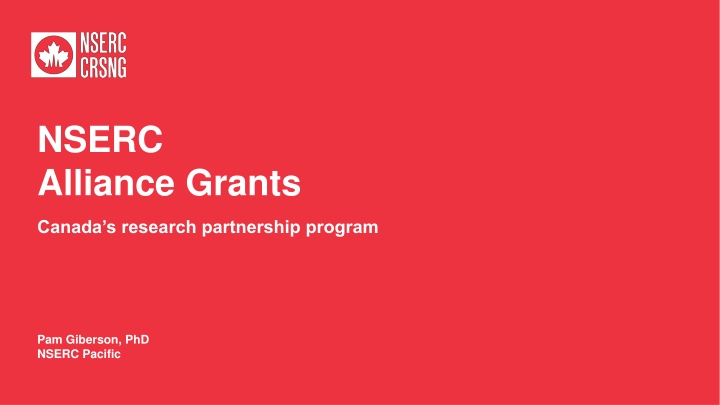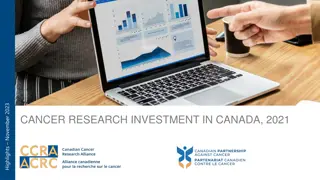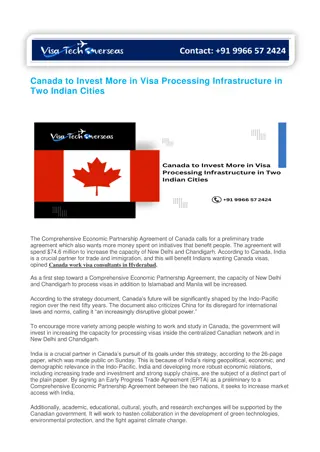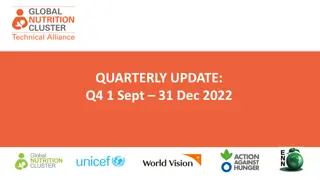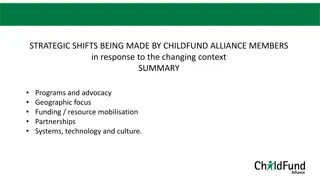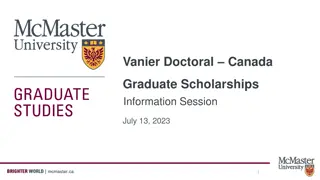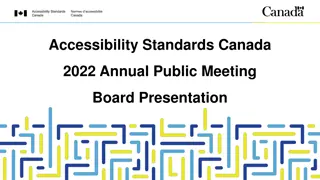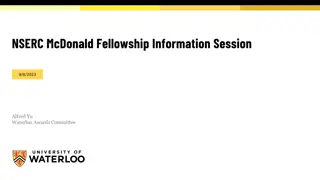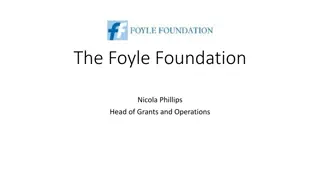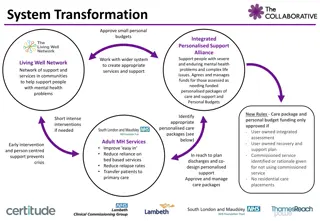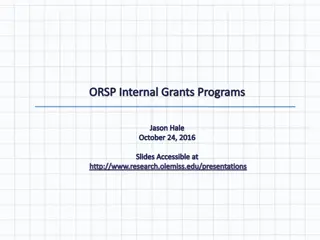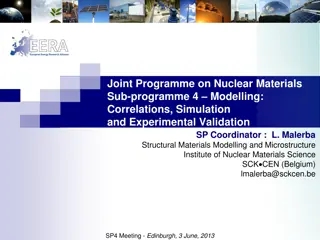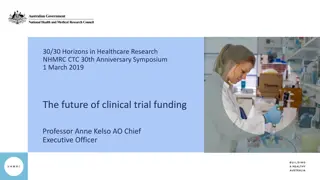NSERC Alliance Grants - Research Partnerships in Canada
NSERC Alliance Grants foster collaboration between university researchers and partner organizations to drive innovation, generate new knowledge, and benefit Canadians. These grants support projects led by collaborative teams and provide a platform for building strong research partnerships. The program is designed to be more flexible, with no restrictions on research topics and simpler application processes, enabling faster decision-making
Download Presentation

Please find below an Image/Link to download the presentation.
The content on the website is provided AS IS for your information and personal use only. It may not be sold, licensed, or shared on other websites without obtaining consent from the author.If you encounter any issues during the download, it is possible that the publisher has removed the file from their server.
You are allowed to download the files provided on this website for personal or commercial use, subject to the condition that they are used lawfully. All files are the property of their respective owners.
The content on the website is provided AS IS for your information and personal use only. It may not be sold, licensed, or shared on other websites without obtaining consent from the author.
E N D
Presentation Transcript
NSERC Alliance Grants Canada s research partnership program Pam Giberson, PhD NSERC Pacific
Alliance grants encourage university researchers to collaborate with partner organizations, which can be from the private, public or not-for-profit sectors. These grants support research projects led by strong, complementary, collaborative teams that will generate new knowledge and accelerate the application of research results for the benefit of all Canadians. 2
Alliance Grants were designed in consultation with the community and create an enabling platform for starting and growing research partnerships, while building on the strengths of our previous Research Partnerships Programs. Alliance Grants more flexible more eligible partners no restriction on research topic no application deadlines simpler process faster decision times Previous Programs Engage Grants Collaborative Research & Development Grants Strategic Grants Industrial Research Chairs 3
Alliance Grants support collaborative projects that will Generate new knowledge / technology Create economic / social / environmental benefits Contribute to Canada s long-term competitiveness Support public policy Train new researchers Draw on diverse perspectives / skill sets 4
Projects can vary in size and scope Short-term projects with one researcher Long-term projects involving several researchers One-on-one collaborations with one partner organization Projects involving many partners organizations from different sectors 5
Grant size and project duration The minimum grant size is $20,000 per year The maximum is $1 million per year Alliance Grant projects can range from 1 year up to 5 years in duration Shorter projects can be scaled up or extended within the maximum 5-year period 6
Research topics Alliance Grants can support any R&D project that responds to a research challenge in the natural sciences or engineering See: Selecting the Appropriate Federal Granting Agency Applicants are encouraged to collaborate with academic researchers in fields other than the natural sciences or engineering Costs for these collaborations must be identified in the project budget Up to a maximum of 30% of the project costs 7
Examples of eligible partner organizations Private Sector Public Sector Not-for-profit Sector Canadian private companies Multinationals with presence in Canada Foreign companies (not as sole partner) Municipalities, local/regional governments Federal/provincial/ territorial government departments (not funding agencies) Public utilities Crown corporations Indigenous governments Producer groups Industrial associations Registered charities with a research mandate Museums/libraries Indigenous groups Community groups 8
Role of partner organizations Every partner organization must do at least one of: Play an active role in research activities Utilize the research results and achieve desired outcomes Play an active role in mobilizing knowledge At least one partner organization must demonstrate ability to exploit research results Other partners may be chosen for their ability to generate and mobilize knowledge Partner organizations must collectively support the project through cash and/or in-kind contributions 9
Cost-sharing 10
Cost-sharing Alliance Grants are calculated based on cost-sharing with the partner organizations The portion that can be cost-shared with NSERC includes only the cash contributions from partner organizations recognized for cost sharing In-kind contributions are important for the success of the project In-kind contributions are considered as part of the proposal evaluation In-kind should not be considered when determining NSERC s contribution to the project costs 11
Cost-sharing options Alliance Grants incorporate a three-tiered cost-sharing structure NSERC will provide: OPTION 1 50% (a 1:1 leverage ratio), 66% (a 2:1 leverage ratio), or OPTION 2 90% to 100% of the shareable costs, depending on the size of the partner organizations and the type of partnership 12
Cost-sharing options . Option 1 Size of partner organization NSERC Contribution to Project costs Type of partnership Parameters Sole partner organization or in partnership exclusively with other large organizations 50% (1:1 leverage) Applications per year: no limits Large organizations* 500+ employees globally As a partner with small and medium-sized enterprises such as in value- or supply-chain relationship, or with other sectors* Grant size: $20,000 to $1 million per year 66% (2:1 leverage) Duration: 1 to 5 years Small and medium organizations* Fewer than 500 employees globally Sole partner organization or in partnership with other sectors* 66% (2:1 leverage) *including private, public and not-for-profit 13
Cost-sharing options .. Option 2 Size of partner organization NSERC Contribution to Project costs Type of partnership Parameters Applications within a 12- month period: Two for non- academic partners Two for applicants (one as the principal investigator, one as co-applicant) Exclusively not-for-profit and public partner organizations 100% All partner sizes Partnership must include one organization that is recognized for NSERC cost- sharing Any private-sector partner organization Requires a 10% cash contribution from the combined partner organizations Grant size: $20,000 to $200,000 per year 90% Duration: 1 to 5 years 14
Partner organizations recognized in cost-sharing calculations Private Sector Cash contributions cannot be recognized Cash contributions can be recognized* Venture capital / Angel investors / Seed stage investment companies Holding companies Companies with fewer than two full-time employees Canadian private companies Multinationals with a presence in Canada Foreign companies (with a Canadian partner) *if NSERC cost-sharing requirements are met 15
Partner organizations recognized in cost-sharing calculations Canadian Public Sector Cash contributions cannot be recognized Cash contributions can be recognized* Municipalities and local or regional governments established by or under provincial or territorial statute Provincial/territorial government departments Federal government departments Indigenous organizations Public utilities Crown corporations Funding organizations (federal, provincial, territorial, international) whose primary mission is to fund R&D Organizations whose primary mission is to perform R&D and are funded or controlled primarily by government Foreign governments *if NSERC cost-sharing requirements are met 16
Partner organizations recognized in cost-sharing calculations Canadian Not-for-Profit Sector Cash contributions cannot be recognized Cash contributions can be recognized* Not-for-profit organizations whose primary mission is to fund R&D and are funded or controlled primarily by government Post-secondary institutions Incubators and accelerators Other registered charities Hospitals and medical/clinical research institutes Philanthropic organizations Consortia with the majority of their funding originating from government sources Foreign not-for-profit organizations Individuals Producer groups Industrial associations Registered charities that have a mandate to carry out and apply research (within natural sciences and engineering) Organizations whose primary mission is to maintain collections (e.g., historical, scientific, artistic, or cultural) for the public good, such as libraries, museums, zoos or aquariums Community organizations *if NSERC cost-sharing requirements are met 17
Cost-sharing example OPTION 1 Large partner organization(s)*only 50% cost-sharing (1:1 ratio) *public, private, or not-for-profit Total project cost: $180,000 Partner(s) cash contribution**: $90,000 NSERC contribution: $90,000 **Contributions recognized in cost-sharing calculation 18
Cost-sharing example OPTION 1 Large partner organization(s) with SME or organizations from other sector(s)* 66% cost-sharing (2:1 ratio) *public, private, not-for-profit Total project cost: $180,000 Partner(s) cash contribution**: $60,000 NSERC contribution: $120,000 **Contributions recognized in cost-sharing calculation 19
Cost-sharing example OPTION 1 Small / medium-sized organizations* 66% cost-sharing (2:1 ratio) *public, private, or not-for-profit Total project cost: $180,000 Partner(s) cash contribution**: $60,000 NSERC contribution: $120,000 **Contributions recognized in cost-sharing calculation 20
Cost-sharing example OPTION 2 Any size of private- sector partner organization 90% NSERC cost-sharing Total project cost: $180,000 Partner(s) cash contribution**: $18,000 NSERC contribution: $162,000 **Contributions recognized in cost-sharing calculation Limit of two applications in a 12-month period 21
Cost-sharing example OPTION 2 100% NSERC cost-sharing Not-for-profit and/or public-sector only Total project cost: $180,000 Partner(s) cash contribution**: $0 NSERC contribution: $180,000 **Contributions recognized in cost-sharing calculation Limit of two applications in a 12-month period 22
Project Budget Projects can be supported by additional sources of funding that are not recognized for cost sharing Such funds can be listed in the project budget, but are not considered as part of the NSERC cost-sharing calculation These additional funds must be described in the proposal and will be considered in the assessment of a proposal s overall merit 23
How to apply Alliance Grant applications are submitted using NSERC s online system - (new Form 101) Fill in the sections of the electronic form Complete the proposal template and supporting documents and include: Form 100A (including the Common CV) of the applicant and of any co- applicants Complete the Template for the Short CV or Biographical Notes (2 pages) of any collaborators Rationale for budget and in-kind contributions from partner organizations Partner Organization Form Any other relevant document (cover page, etc.) See the instructions for NSERC s online system 25
How to complete the proposal
Proposal Sections & Length Average annual request Suggested number of pages per section Up to & including $30,000/year $30,001 to $300,000/year More than $300,000/year More than $750,000/year Section Background and Expected Outcomes 1 2 3 3 Partnership 1 2 3 5 Proposal 2 4 5 10-15 Team 0.5 1 2 4 Training Plan 0.5 1 2 3 Total number of pages including NSERC template text Total 5 10 15 25-30
Assessment of applications
How applications are reviewed NSERC has adopted a financial risk-based approach that includes various assessment tools Reduces burden and delays Recognizes risk as a function of project complexity and funds requested 29
Review of the application Project Size Small Medium Large Approximate thresholds Average annual request of $20,000 to $30,000 Average annual request of $30,001 to $300,000 Average annual request of $300,001 to $1,000,000 External Referees With expertise directly related to the proposal Provide review based on all evaluation criteria Ad hoc committee members With expertise directly related to the proposal Provide review based on all evaluation criteria NSERC File Managers Evaluation supported by existing NSERC peer review (i.e. Discovery Grant rating, active Canada Research Chair holders, prior Partnership grants, etc.) If no existing NSERC peer review evidence is available, external reviewers will be used Review mechanism Funding decisions Expected assessment time* NSERC assigns merit indicators to determine priority for funding 4 weeks 8-12 weeks 12-16 weeks 30
Evaluation Criteria
Evaluation criteria Applications are evaluated using the following criteria: Relevance and outcomes Partnership Quality of the proposal Training 32
Evaluation criteria Relevance and outcomes Significance of the intended outcomes and of the economic, social and/or environmental benefits for Canada Originality of research and production of new scientific knowledge Strategy to apply the results 25% Partnership Relevance to achieve the expected results; leveraging of different types of partner organizations and the integration of their unique perspectives and knowledge in the project, as appropriate Role in defining the challenge, co-designing and implementing the research, and using the results to achieve the desired outcomes Appropriateness of the level of cash and in-kind contributions from each partner organization 25% 33
Evaluation criteria Quality of the proposal Clarity of the objectives and deliverables; appropriateness of the scope and size of planned activities to achieve the expected outcomes; justification for the planned expenditures Appropriateness of the identified indicators and methods for monitoring progress during the project and for assessing outcomes afterwards Appropriateness of academic researchers expertise, and that found within the partner organizations, both for carrying out the planned research activities and in mentoring trainees Training Opportunities for enriched training experiences for research trainees (undergraduates, graduates, postdoctoral fellows) to develop relevant research skills as well as professional skills such as leadership, communication, collaboration and entrepreneurship. Consideration of diversity and gender equity in the training plan 25% 25% 34
Equity, diversity and inclusion NSERC is committed to excellence in research and research training for the benefit of Canadians. Achieving a more equitable, diverse and inclusive Canadian research enterprise is also essential to creating the excellent, innovative and impactful research necessary to seize opportunities and respond to global challenges. 35
Equity, diversity and inclusion You are asked to consider sex, gender and diversity in the project s research design and to consider how to promote and support a variety of forms of mentoring to ensure trainees equitable participation and growth. In large proposals, you must strive for equity, diversity and inclusion when developing your group of co-applicants, partners and trainees See Guide for Applicants: Considering equity, diversity, and inclusion in your application 36
How are funding decisions made ...
Funding Decisions Financing decisions will be made on a competitive basis Assessment using the evaluation criteria Merit indicators Ranking according to overall merit Applications with the highest merit will be funded until the budget of the period in question is exhausted 38
Scaling-up successful research collaborations NSERC will support the growth of a project as the partnership progresses by providing options to expand successful projects Additional funds can be awarded within the original timeframe or during additional years of the project Maximum project duration (including any time extension) is five years Procedure for expanding projects will be detailed at a later date 40
Alliance Grants timeline 41
Alliance Option 2 This component of Alliance is still under development. It is intended for natural science/engineering research proposals that: aim to address an unmet societal need (may include research affecting public goods, or that will address national or global issues that benefit more than a single or a few organizations) Visit the connect partner organizations willing and able to overcome existing barriers to address these challenges and achieve results that can lead to societal impact beyond economic benefits for updates More details on the objectives and on the application and evaluation processes will be available soon 42
Alliance Grants Single point of entry for university research partnerships Support multi-sectoral partnerships Various levels of cost sharing Simplified processes Flexible Focus on project outcomes Competitive
More than research funding: It s about collaboration Alliance grants support truly collaborative projects Partner organizations are involved at all stages, including: co-designing the project actively participating in the research implementing/mobilizing project outcomes for the benefit of Canada and Canadians
Useful Links Alliance Grants Website Instructions for completing an Alliance Grant application Role of partner organizations Evaluation Criteria Merit Indicators Use of Grant Funds FAQ 46
NSERC Head Office 613-995-1111 alliance@nserc-crsng.gc.ca Thank you! NSERC Regional Offices Toll-free 1-877-767-1767 nserc-atlantic@nserc-crsng.gc.ca nserc-ontario@nserc-crsng.gc.ca nserc-pacific@nserc-crsng.gc.ca nserc-prairies@nserc-crsng.gc.ca nserc-quebec@nserc-crsng.gc.ca 47
